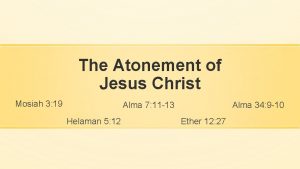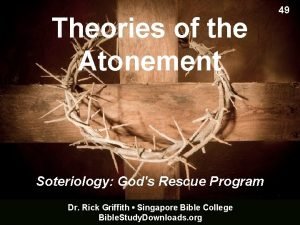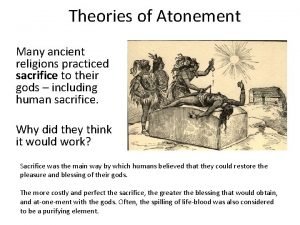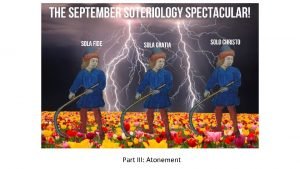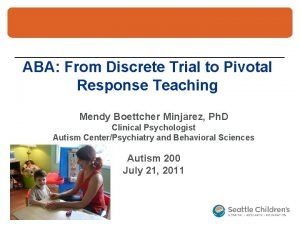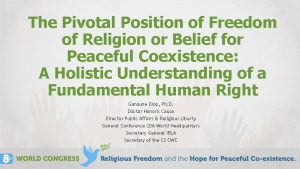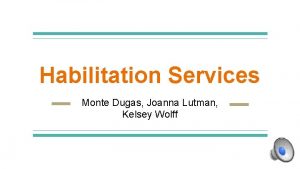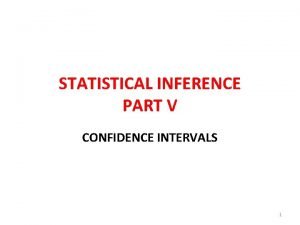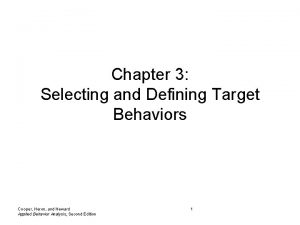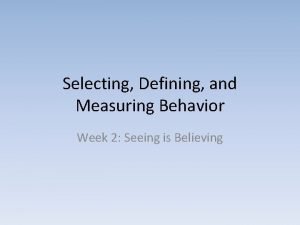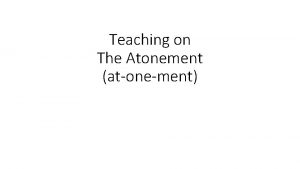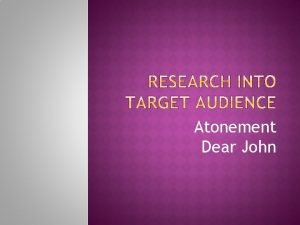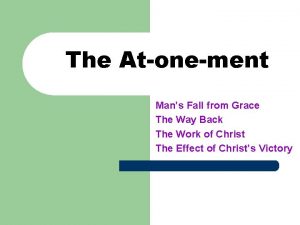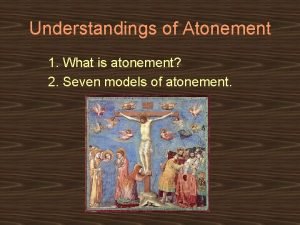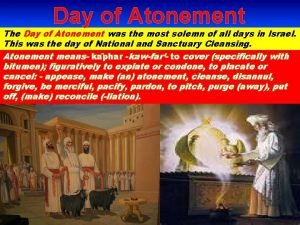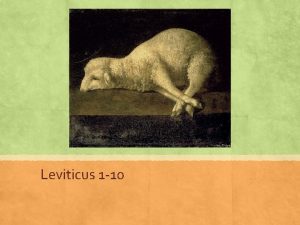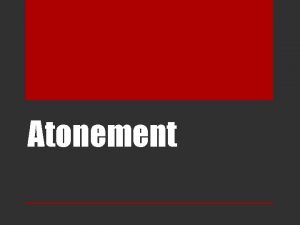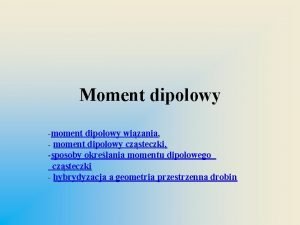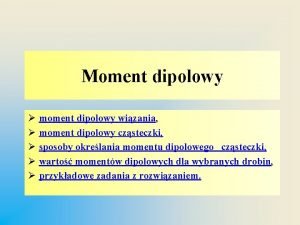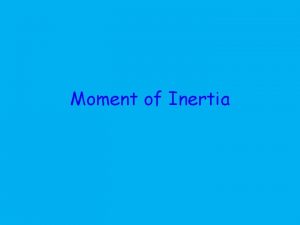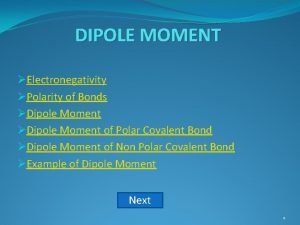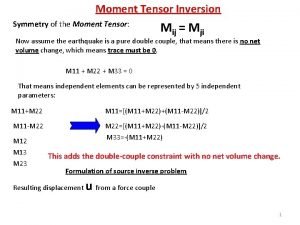The Atonement A pivotal moment in the coming





















- Slides: 21

The Atonement A pivotal moment in the coming of the Kingdom

The kingdom hermeneutic 1. If Jesus’ mission and message of the kingdom has been rediscovered fairly recently in the history of theology, then a fresh departure, which elevates his insights to a hermeneutical key, is called for. 2. Since his message of the kingdom emerged out of the collection of eschatological expectations in Judaism during his era, it must unlock the meaning of those expectations. 3. Since those expectations arose out of the history of Israel, it must somehow unlock the meaning of Old Testament theology as well. 4. Since Jesus message of the kingdom is the historical genesis of the early church, all the literature of the early church must reflect, in some sense, Jesus’ message of the kingdom. His understanding of the kingdom must unlock the meaning of the New Testament as well.

Kingdom hermeneutic methodology 1. The discovery of Jesus’ mission and message of the kingdom (inaugurated eschatology) has taken place during the same period as the development of biblical theology. 2. Biblical theology has led to the development of a narrative or metanarrative approach to scripture. 3. Therefore, the kingdom hermeneutic begins with Jesus’ mission and message of the kingdom, elevates this as a hermeneutical key and then uses this to read all of scripture. 4. The resulting narrative theology is then used to review and critique creedal orthodoxy, systematic, historical and Reformed theology. Assuming Breakthrough, 5 th Edition

Closely interlocking ideas Demonstration: Healing & exorcism Messianic Fulfilment Kingdom coming Good news Isaiah 61 Israel: Mosaic, Davidic, Prophetic

The Mosaic coming of the kingdom

Moses and Jesus 1. The Mosaic coming of the kingdom is the archetypal founding event if Israel’s faith and biblical revelation. 2. The phrase “signs and wonders” begins with the plagues of Egypt and is then repeated as a description of the ministry of Jesus. John’s gospel is structured around 7 signs and 7 discourses. 3. Matthew’s structure of 5 blocks of teaching that mirror the 5 books of the Pentateuch reveals Jesus as the new and greater Moses. 4. Jesus introduces the new covenant in his blood as a new Passover in a new Exodus.

Mosaic kingdom architecture 1. Presence: The divine name (Yahweh) 2. Kingdom: The event of deliverance/redemption 3. Covenant: The terms of the King-vassal relationship 4. Elect community: The Holy/Priestly nation 5. Covenant maintenance: The Law/Torah, the priesthood and the sacrifices 6. Covenant benefits: The good life, the Promised Land (the journey to that land) 7. Mission: The destiny of the people of God

Jesus the Messiah 1. Presence: the word became flesh and tabernacle among us 2. Kingdom: Announcing and demonstrating the kingdom, liberating the captives 3. Covenant: This is the blood of the new covenant 4. Elect community: I will build my church (12 + 70) 5. Covenant maintenance: Born again through the Spirit, from the inside out 6. Covenant benefits: we inherit the world, a new heaven and a new earth 7. Mission: Witness in Jerusalem, Judea and to the ends of the earth Your kingdom come, your will be done, on earth as it is in heaven.

The Mosaic coming of the kingdom Three key texts God said to Moses, ‘I am who I am. This is what you are to say to the Israelites: “I am has sent me to you. ”’ (Exodus 3: 14). The Name - Yahweh ‘On that same night I will pass through Egypt and strike down every firstborn of both people and animals, and I will bring judgment on all the gods of Egypt. I am the LORD (12: 12). The war against the gods ‘The LORD reigns for ever and ever. ’ (15: 18). Yahweh is king

The plagues: spiritual warfare # Plague Deities 1 Nile turned to blood Osoris, Isis, Horus and specially Ha’pi, god of the nile 2 Frogs Heqit, goddess of fertility and water renewal 3 Lice, gnats or sand flies Geb, god of the earth and vegetation 4 Flies, literally “swarms” Kepfi, god of creation, movement of the sun, insects 5 Livestock 6 Boils, or “botch” 7 Hail, thunder and fire 8 Locusts 9 Darkness Ra the sun god, Horus god of the sunrise, Shu god of light 10 Firstborn Pharoah, son of Ra s r e d n Apis/Mnevis – bull; Hathor – cow; Khnum - ram o W dgod of medicine and Isis, goddess of medicine Thoth (Imhotep), n a s n Nutig goddess of the sky, Shu the wind god, Horus sky god S Nepri grain god, Anubus god of the fields, Seth protector of crops

Suzerainty Treaties 1. Preamble or title 2. Historical prologue 3. General stipulations 4. Specific stipulations 5. Deposition of a copy a) In the sanctuary of the vassal b) The periodic public reading of the covenant 6. Witnesses 7. Curses and blessings a) Curses if the treaty is broken b) Blessings if the treaty is kept

The ark of the covenant Where Yahweh is enthroned between the cherubim

Implications for atonement 1. Israel is victim (not specifically sinner), yet saved by grace (not deserving or righteous). 2. The Psalms, a repository of kingdom theology that repeatedly reflect back on the Mosaic foundations, construe Yahweh’s redemption and justice in terms of liberation from oppression, delivering his people from his/their enemies through kingdom warfare. This is primarily restorative justice. 3. 4. 5. y g o The archetypal notion of substitution is found in the blood of the lamb offered instead of the l o first-born slain in the final plague. Every Israelite familyhiseforever “bought with a price. ” But tintervention. this is a small part of the larger narrative of kingdom r o t c Law, as Torah (instruction for the good life)iis the result of kingdom and covenant. Nevertheless, V Yahweh is both liberator and legislator. h The blessings and curses of the suzerainty treaty assume e a notion of retributive justice asw well. h Ya. Day of Atonement, are part of the system of covenant maintenance, The sacrifices, including the not covenant genesis, not the founding kingdom/redemptive event itself. 6. The mercy seat is the place where covenant faithlessness is mitigated (atoned) through sacrifice. 7. The ritual of the Day of Atonement, while part of covenant maintenance, not genesis, nevertheless is almost impossible to conceive of without the notion of substitutionary sacrifice.

The Prophetic coming of the kingdom

Habakkuk A G R O W I N G V I S I O N Jeremiah The past repeated A better future Ezekiel Transcending the past Isaiah The past eclipsed Daniel The new world

Jeremiah: a better future 1. Deception: “The temple of the Lord, the temple of the Lord. ” Israel’s sin: idolatry! 2. After 70 years, a return. 3. A new Davidic kingship. 4. A new covenant: “I will put my law in their minds and write it on their hearts. ” Overcoming the fatal flaw

Ezekiel: transcending the past 1. The divine presence, leaving and returning (the mobile ark of the covenant). Idolatry! 2. One Davidic kingship. 3. An everlasting covenant. 4. A regenerated nation: “These dry bones will live. ” A new heart of flesh, not stone. 5. A new temple. Overcoming the fatal flaw

Isaiah: The past eclipsed 1. The glory of the Lord embarrassing the sun. 2. A universal Davidic king = the Suffering Servant 3. An overwhelming outpouring of the Spirit. Salvation: 1. Forgiveness. 2. Healing. 3. Liberation. 4. Shalom/peace. 5. Resurrection. 6. Celebration. Salvation A new reality: 1. A new people. Renewal 2. A new Jerusalem. of 3. A new heaven and new earth. creation 4. Final judgment of evil.

Daniel Son. Rock of Man J U D G M E N T A new humanity Ha-‘olam haba…The Age to Come Resurrection: Eternal life Eternal death M/P B G R Ha-‘olam hazeh…………………. This Age End Eschatos

Implications for atonement 1. Israel is victim and sinner. Forgiveness and liberation from the oppressor is required. s e t a n i The Servant is first Israel, then the remnant, then the individual embodiment m of the nation. This o d is a representative and substitutionary figure. Isaiah names the servant as a sin offering. This e r p then reflects back on the meaning of the Day of Atonement sacrifice as substitutionary. y g Daniel’s son of man is also a representative figure (the o new humanity). The son of lo. Israel/new e man is an eschatological figure who acts as the judge of humanity to inaugurate the new h t humanity. n o i t a The sum total of Isaiah and Daniel (theeprimary influences on Jesus) is a vision of the r c eschatological renewal of all of creation, or salvation in the most comprehensive terms w e (forgiveness, healing, liberation, resurrection and final judgment of evil). n / n the Mosaic architecture, adds the shalom of Davidic messiahship, o The prophetic visioniassumes t a and then projects it form a massive expectation. Key ideas are shalom (Davidic) and salvation r o (Isaiah). est R Substitutionary atonement is there (the suffering servant) but this is a small part of a much 2. Redemption must go beyond forgiveness, it must address the fatal flaw of human nature (imputed and imparted justification). 3. 4. 5. 6. 7. larger vision.

Restoration language in the NT Jesus said to them, ‘Truly I tell you, at the renewal of all things [παλιγγενεσία/palingenesia], when the Son of Man sits on his glorious throne, you who have followed me will also sit on twelve thrones, judging the twelve tribes of Israel (Matthew 19: 28 = Titus 3: 5) Then they gathered round him and asked him, ‘Lord, are you at this time going to restore [ἀποκαθίστημι/apokathistēmi] the kingdom to Israel? ’ (Acts 1: 6) ‘Now, fellow Israelites, I know that you acted in ignorance …Repent, then, and turn to God…that he may send the Messiah, who has been appointed for you – even Jesus. Heaven must receive him until the time comes for God to restore everything [ἀποκατάστασις/apokatastasis], as he promised long ago through his holy prophets (Acts 3: 17 -21). That day will bring about the destruction of the heavens by fire, and the elements will melt in the heat. But in keeping with his promise we are looking forward to a new heaven and a new earth, where righteousness dwells (2 Peter 3: 11 -13). Then I saw ‘a new heaven and a new earth, ’ for the first heaven and the first earth had passed away, and there was no longer any sea. I saw the Holy City, the new Jerusalem, coming down out of heaven from God, prepared as a bride beautifully dressed for her husband (Revelation 21: 1 -2).
 Mosiah 3:19
Mosiah 3:19 Joseph campbell atonement with the father
Joseph campbell atonement with the father Atonement theories
Atonement theories Propiatory
Propiatory Robert govett
Robert govett Example of pivotal response training
Example of pivotal response training Pivotal position
Pivotal position Pivotal credit card processing
Pivotal credit card processing Behavior cusp vs pivotal behavior
Behavior cusp vs pivotal behavior Confidence level
Confidence level Triluminate pivotal trial
Triluminate pivotal trial Pivotal prayer
Pivotal prayer Habilitation definition aba
Habilitation definition aba Frequency behavior data sheet
Frequency behavior data sheet Thiếu nhi thế giới liên hoan
Thiếu nhi thế giới liên hoan Vẽ hình chiếu vuông góc của vật thể sau
Vẽ hình chiếu vuông góc của vật thể sau Hát kết hợp bộ gõ cơ thể
Hát kết hợp bộ gõ cơ thể Các châu lục và đại dương trên thế giới
Các châu lục và đại dương trên thế giới Một số thể thơ truyền thống
Một số thể thơ truyền thống Thế nào là hệ số cao nhất
Thế nào là hệ số cao nhất Lp html
Lp html Hệ hô hấp
Hệ hô hấp
